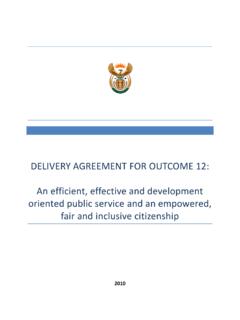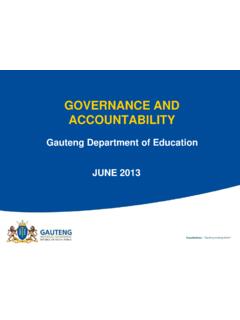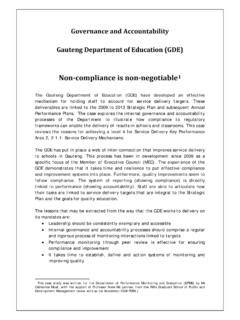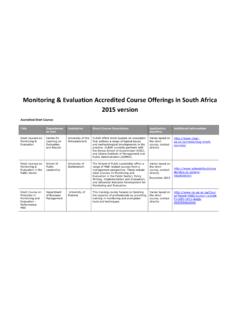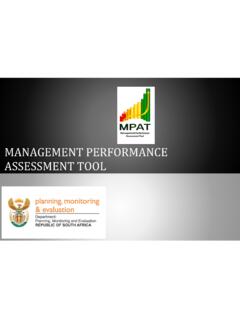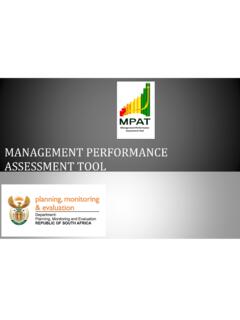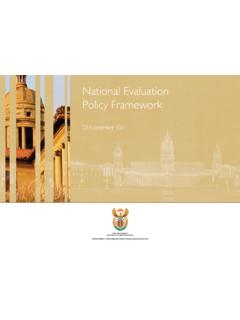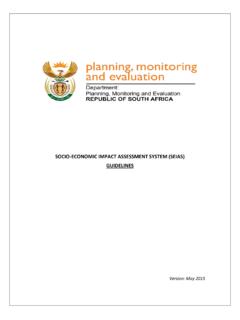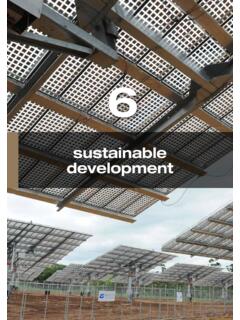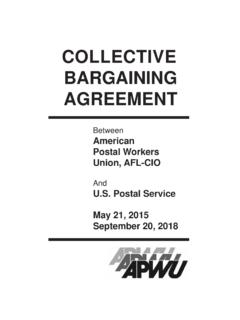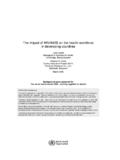Transcription of DELIVERY AGREEMENT For Outcome 4: Decent employment ...
1 DELIVERY AGREEMENT . For Outcome 4: Decent employment through inclusive growth 20 October 2010. 1. Contents INTRODUCTION .. 3. 1. CONTEXT AND HIGH LEVEL PROBLEM STATEMENT .. 3. 2. IDENTIFICATION OF DELIVERY PARTNERS .. 3. 3: LINKING OUTPUTS TO Outcome 4: WHAT WILL BE DONE DIFFERENTLY .. 5. 4. ACTIONS NEEDED TO ACHIEVE EACH OUTPUT .. 9. output 1: faster and sustainable inclusive 9. output 2: More labour absorbing growth .. 14. output 3: Multi-pronged strategy to reduce youth unemployment .. 19. output 4: Increased competitiveness, to raise net exports, grow trade as a share of world trade and improve its composition .. 19. output 5: improved cost structure in the economy .. 22. output 6: Improved support to small business and cooperatives.
2 23. output 7: implementation of the expanded public works programme .. 24. 5, INDICATORS, BASELINES AND TARGETS FOR Outcome .. 27. 7. RISKS, CONSTRAINTS AND MITIGATION STRATEGIES .. 27. 8. GOVERNANCE AND REPORTING ARRANGEMENTS .. 28. 9. SIGNATORIES .. 28. ANNEXURE 1: INDICATORS, BASELINES AND TARGETS FOR Outcome .. 59. 2. INTRODUCTION. Government has agreed on 12 outcomes as a key focus of work between now and 2014. Each Outcome has a limited number of measurable high-impact priority outputs and sub-outputs with targets. In turn, each output is linked to a set of activities that will help achieve the targets and contribute to the Outcome . Each of the 12 outcomes has a DELIVERY AGREEMENT which in most cases involve all spheres of government and a range of partners outside government.
3 Combined, these agreements reflect government's DELIVERY and implementation plans for its foremost priorities. This DELIVERY AGREEMENT is a negotiated charter which reflects the commitment of the key partners involved in the direct DELIVERY process to working together to undertake activities effectively and on time to produce the mutually agreed-upon outputs which in turn will contribute to achieving the Outcome of Decent work through inclusive growth. The DELIVERY AGREEMENT provides detail to the outputs, targets, indicators and key activities to achieve Outcome 4, identifies required inputs and clarifies the roles and responsibilities of the various DELIVERY partners. It spells out who will do what, by when and with what resources.
4 The outcomes apply to the whole of government and are long term. While the DELIVERY AGREEMENT may contain longer term outputs and targets, it also includes outputs and associated targets that are realisable in the next 4 years. It also considers other critical factor impacting on the achievement of Outcome 4 , such as the legislative and regulatory regime, policy framework, the institutional environment and decision-making processes, the resources needed and re-allocation of resources where appropriate. This DELIVERY AGREEMENT will be reviewed annually in the light of learning by doing and monitoring and evaluation (M&E) findings. Accordingly it will be refined over time and become more inclusive of the relevant DELIVERY partners.
5 1. CONTEXT AND HIGH LEVEL PROBLEM STATEMENT. South Africa continues to experience high levels of unemployment compared to other countries at the same level of development. This contributes to high levels of poverty and inequitable distribution of income. In addition, the economy faces a number of structural constraints that impact on its ability to generate growth and support employment creation in the long-term. Addressing the unemployment challenge and the structural constraints of our economy will require active investment and interventions 3. by the state to create an enabling environment to stimulate inclusive growth and support the creation of Decent employment on a large scale. Over the MTSF period the Cluster will track the following key outcomes which form part of the National Objectives and will inform Cluster's interventions contained in this DELIVERY AGREEMENT .
6 These include: 1. Income and equality a. Increased average income and reduced levels of poverty b. Increased socio-economic equality for all sectors of the population 2. Labour Absorption and employment a. Decent employment accelerating employment creation. b. Higher rates of labour absorption, meaning that more of the working-age population has jobs 3. GDP Growth a. High rates of employment generating growth indicating economic expansion 4. Diversification of the Economy a. Movement towards a greater balance between primary, secondary and tertiary sectors There are a number of policy interventions that have either been developed or are currently being developed to address the structural imbalances that have resulted in high levels of unemployment, poverty and inequality.
7 These policies define the interventions contained in this DELIVERY AGREEMENT and will continue to shape government response in addressing the developmental challenges. Principal amongst these are the Developmental Growth Path, IPAP and the Ten Year Innovation Strategy. The Industrial Policy Action Plan begins to identify areas where employment could be leveraged and Key Action Plans (KAPs) to achieve the positive employment outcomes. Another key policy that informed the Cluster's DELIVERY AGREEMENT is the Ten Year Innovation Plan which spells out critical intervention to drive South Africa's transformation towards the knowledge-based economy 4. 2. IDENTIFICATION OF DELIVERY PARTNERS. Delivering on the creation of Decent work through inclusive growth will require cooperation amongst government departments, state agencies and stronger participation of social partners in the development and implementation of government policies.
8 While the core participants will be government departments, collaboration with business and labour will be crucial. As the DELIVERY AGREEMENT is refined and further improved, the role of social partners in the achievement of the Outcome will be managed by social pacts. The Public Sector DELIVERY Partners are highlighted in the table below. Chairing Department Coordinating Departments Supporting Departments State Entities DRDLR DTI, NT & EDD DST, DPE, DAFF, NDT, DMR, DOL, IDC, SARB, ITAC. DOC, DOE, DEA, DWA, NPC, DPW, Competition Com, Higher Education, DIRCO, COGTA, Khula, SEDA, Samaf, DoT, Provincial and Local Eskom, Transnet, Government TIA, CSIR, FFC, SA. Tourism, DBSA. The implementation forum will also ensure cohesion between Outcome 4 and the following outcomes Outcome 5: A skilled and capable workforce to support an inclusive growth path Outcome 6: An efficient, competitive and responsive economic infrastructure network Outcome 7: Vibrant, equitable and sustainable rural communities with food security for all Outcome 10: Environmental assets and natural resources that is well protected and continually enhanced 3: LINKING OUTPUTS TO Outcome 4 : WHAT WILL BE DONE DIFFERENTLY.
9 Creation of Decent employment opportunities is an Outcome of most, if not all government initiatives. This AGREEMENT focuses on the fundamental outputs that would need to be achieved in the current administration period, to promote employment creation and increase the number of Decent jobs, stimulate inclusive growth and further diversify the economy towards more employment generating and higher value added activities. The table below provides a summary of the main outputs, with a more complete table attached at the end of this document. 5. Output What's new Output 1: Faster and sustainable inclusive growth Sub-output 1: The Align economic policies toward stronger focus on employment Developmental Growth Path creation and equity, with stringent re-prioritisation and monitoring Sub-output 2: Measurement StatsSA to fast-track re-introduction of income data in household of Income Distribution surveys Sub-output 3: Stable and Policy package to reduce volatility and ensure more competitive competitive exchange rate exchange rate Sub-output 4: Increased Improve conditions for savings by private households and private savings companies Sub-output 5.
10 Monetary Improve communication//engagement strategy on monetary policy policy approach that by the SARB. supports balanced and sustained growth Frequent interactions between the Minister of Finance and the Governor of the Reserve Bank and regular updates on monetary policy issues to Cabinet Increased coordination on factors that drive inflation Sub-output 6: Counter- Framework takes into account new global and national conditions cyclical fiscal policy and is sensitive to cyclical requirements Budget aligned with MTSF and developmental growth path aims Publishing 5-year debt projections Monitoring the impact of fiscal policy on expenditure growth, government savings, employment , inequality and inflation, with annual report to Cluster 6.
